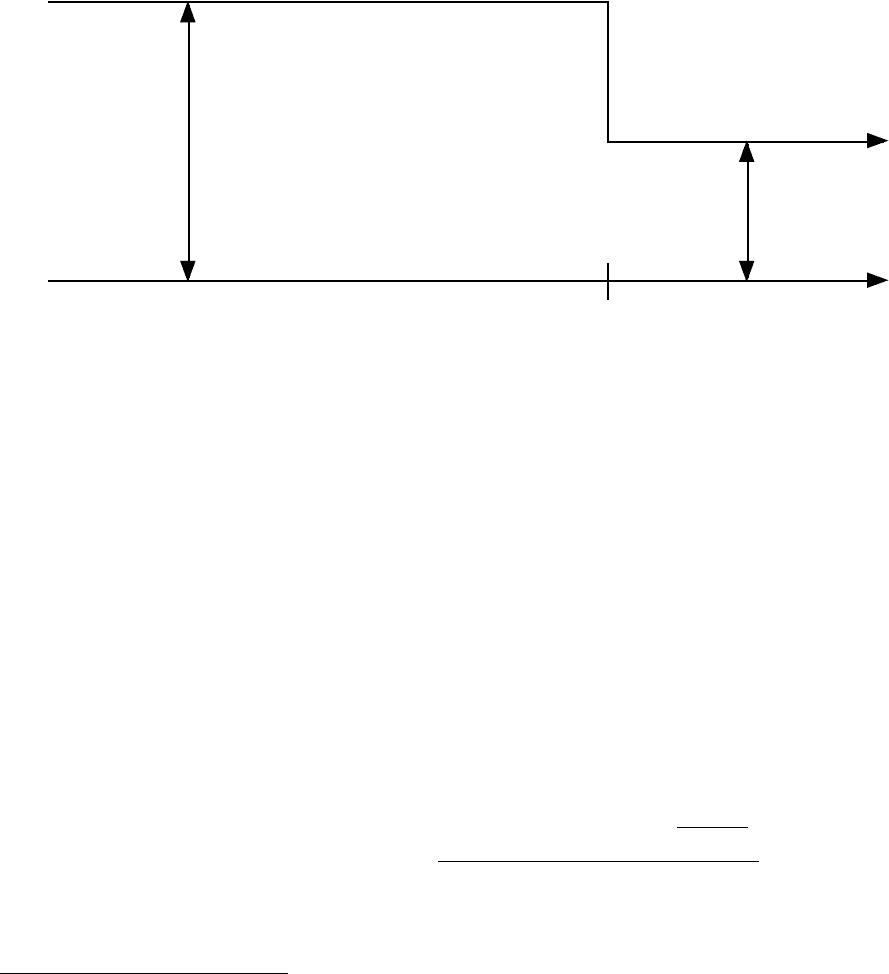Damodaran A. Applied corporate finance
Подождите немного. Документ загружается.


7
7
growing at 4% will eventually become larger than the economy. In practical terms, the
stable growth rate cannot be larger than the nominal (real) growth rate in the economy in
which the firm operates, if the valuation is done in nominal (real) terms.
Can a stable growth rate be much lower than the growth rate in the economy?
There are no logical or mathematical limits on the downside. Firms that have stable
growth rates much lower than the growth rate in the economy will become smaller in
proportion to the economy over time. Since there is no economic basis for arguing that
this cannot happen, there is no reason to prevent analysts from using a stable growth rate
much lower than the nominal growth rate in the economy. In fact, the stable growth rate
can be a negative number. Using a negative stable growth rate will ensure that your firm
peaks in your last year of high growth and becomes smaller each year after that.
There is one rule of thumb that works well in setting a cap on the stable growth
rate. The stable growth rate should generally not exceed the riskfree rate used in a
valuation. Why should the two be related? The riskfree rate can be decomposed into an
expected inflation rate and an expected real interest rate. If we assume that the real
growth rate of an economy will be equal to the real interest rate in the long term, the
riskfree rate becomes a proxy for the nominal growth rate in the economy.
12.2 ☞: Cyclical firms and Constant Growth Rates
Models that are built on the assumption of an expected constant growth rate over time
cannot be used for cyclical firms, whose earnings growth is likely to be very volatile over
time - high during economic booms, and very low or negative during recessions.
a. True
b. False
Explain.
Estimation in DCF Models
While all discounted cashflow models require the same four ingredients –
cashflows, a discount rate, a period of high growth and a growth rate during the period,
there are different estimation challenges we face with each model. In this section, we will

8
8
begin by estimating these inputs to the simplest of the three models, the dividend
discount model, and then extend the discussion to cashflow to equity and firm valuation
models.
I. Dividend Discount Models
When an investor buys stock, he generally expects to get two types of cash flows -
dividends during the holding period and an expected price at the end of the holding
period. Since this expected price is itself determined by future dividends, the value of a
stock is the present value of just expected dividends. The dividend discount model is
therefore the most direct and the most conservative way of valuing a stock since it counts
only those cashflows that are actually paid out.
Setting up the Model
In it’s most general form, the value of a stock in the dividend discount model is
the present value of the expected dividends on the stock in perpetuity.
Value per share of stock =
!
Expected Dividends in period t
(1 +Cost of Equity)
t
t =1
t ="
#
Since we cannot estimate dividends in perpetuity, we
generally allow for a period where dividends can grow at
extraordinary rates but we allow for closure in the model
by assuming that the growth rate will decline to a stable
rate that can be sustained forever at some point in time in
the future. By assuming stable growth at some point in time in the future, we can stop
estimating dividends and estimate what we think the stock will be worth at the end of the
extraordinary growth period.
!
Value
0
=
E(Dividends)
t
(1 + r)
t
t =1
t =n
"
+
Terminal Value
n
(1 +r)
n
where Terminal Value
n
=
E(Dividends)
n +1
(r
n
- g
n
)
Terminal Value: This is the
expected price of a stock (or
equity) at the end of a
specified holding period.

9
9
where r is the cost of equity and g
n
is the expected growth rate in dividends in perpetuity
after year n.
2
Note that it is possible for a firm to already be in stable growth, in which
case this model collapses into itls simplest form:
Value of a stock in stable growth = Expected Dividends next year/ (Cost of equity – g
n
)
This model is called the Gordon Growth model and is a special case of the dividend
discount model. It can be used only for firms that are already in stable growth.
3
Estimating Model Inputs
Breaking down the general version of the dividend discount model, there are four
basic components. The first is the length of the high growth period, during which the firm
can sustain extraordinary growth. The second is the expected dividends each year during
the high growth period. The third is the cost of equity that stockholders will demand for
holding the stock, based upon their assessments of risk. The final input is the expected
price at the end of the high growth period – the terminal value. In this section, we will
consider the challenges associated with estimating each of these components.
a. Length of High-Growth Period
The question of how long a firm will be able to sustain high growth is perhaps the
most difficult of all to answer in a
valuation, but two points are worth
keeping in mind. One is that it is not a
question of whether but when; all firms
will ultimately be stable growth firms, because high growth makes firms larger, and the
firm’s size will eventually become a barrier to further high growth. The second is that
high growth in valuation, at least high growth that creates value, comes from firms
earning high returns on their marginal investments. Using the terminology that we have
used before in investment analysis, it comes from firms having a return on equity
(capital) that is well in excess of the cost of equity (capital). Thus, when we assume that a
2
The cost of equity can be different for the high growth and stable growth periods. Hence, r
n
is the cost of
equity for the stable growth period.
3
When the Gordon Growth model is used to value high growth companies, it is entirely possible that g>r
and the model will yield a negative value. The problem is not with the model but in its msapplication to a
high growth firm.
High Growth Period: This is a period during which
a company’s earnings or cash flows are expected to
grow at a rate much higher than the overall growth
rate of the economy.
10
10
firm will experience high growth for the next 5 or 10 years, we are also implicitly
assuming that it will earn excess returns (over and above the cost of equity or capital)
during that period. In a competitive market, these excess returns will eventually draw in
new competitors, and the excess returns will disappear.
We should look at three factors when considering how long a firm will be able to
maintain high growth.
1. Size of the firm: Smaller firms are much more likely to earn excess returns and
maintain these excess returns than otherwise similar larger firms. This is so because
they have more room to grow and a larger potential market. When looking at the size
of the firm, we should look not only at its current market share, but also at the
potential growth in the total market for its products or services. Thus, Microsoft may
have a large market share of the computer software market, but it may be able to
grow in spite of it because the entire software market is growing. On the other hand,
Boeing dominates the market for commercial airliners, but we do not expect the
overall market for airliners to increase substantially. Boeing, therefore, is far more
constrained in terms of future growth.
2. Existing growth rate and excess returns: Although the returns we would like to
estimate are the marginal returns on new investments, there is a high correlation
between the returns on current investments and these marginal returns. Thus, a firm
earning excess returns of 20% on its current investments is far more likely to have
large positive excess returns and a long growth period than a firm currently earning
excess returns of 2%. There are cases where this rule will not work, such as in new
industries going through major restructuring.
3. Magnitude and Sustainability of Competitive Advantages: This is perhaps the most
critical determinant of the length of the high growth period. If there are significant
barriers to entry and sustainable competitive advantages, firms can maintain high
growth for longer periods. If, on the other hand, there are no or minor barriers to
entry, or if the firm’s existing competitive advantages are fading, we should be far
more conservative about allowing for long growth periods. The quality of existing

11
11
management also influences growth. Some top managers
4
have the capacity to make
the strategic choices that increase competitive advantages and create new ones.
Again, the sensitivity of value to changes in the length of the high growth period can
always be estimated. While some analysts use growth periods greater than 10 years, the
combination of high growth rates and long growth periods creates a potent mix in terms
of increasing the size of the firm, in many cases well beyond the realm of what is
reasonable. Looking back, there are very few firms that have been able to grow at high
rates for more than 10 years.
Illustration 12.1: Length of High Growth Period
To assess how long high growth will last at Disney, Aracruz and Deutsche Bank,
we assessed their standings on each of the above characteristics in Table 12.1:
Table 12.1: Assessment of Length of High Growth Period
Disney
Aracruz
Deutsche Bank
Firm Size/Market Size
Firm is one of the
largest players in the
entertainment and theme
park businesses but the
businesses are
redefining themselves
and expanding.
Firm has a small market
share of the paper/pulp
business, but the
business is mature.
Firm has a significant
market share of a mature
business.
Current Excess Returns
Firm is earning less than
its cost of capital, and
has done so for last few
years
Returns on capital are
largely a function of
paper/pulp prices but, on
average, have been less
than the cost of capital.
Firm has a return on
equity that has lagged its
cost of equity in recent
years.
Competitive Advantages
Has some of the most
recognized brand names
in the world. Knows
more about operating
theme parks than any
other firm in the world.
Has skilled animation
studio staff.
Cost advantages because
of access to Brazilian
rainforests. Has invested
in newer, updated plants
and has skilled
workforce.
Has an edge in the
commercial banking
business in Germany but
this advantage is
dissipating in the EU.
Length of High Growth
period
10 years, entirely
because of its strong
competitive advantages
(which have been
wasted over the last few
years) but the excess
returns are likely to be
5 years, largely due to
access to cheap raw
material.
5 years, mostly to allow
firms to recover to pre-
downturn levels.
4
Jack Welch at GE and Robert Goizueta at Coca Cola are good examples of CEOs who made a profound
difference in the growth of their firms.

12
12
small.
What about Bookscape? The single biggest competitive advantage possessed by the firm
is its long-term lease, at favorable terms, in a superb location in New York City. It is
unlikely that the firm will be able to replicate this advantage elsewhere. Adding to this
the fact that this is a private firm leads us to conclude that there will be no high growth
period.
12.3. ☞: Length of High Growth Period and Barriers to Entry
Assume that you are analyzing two firms, both of which are enjoying high growth. The
first firm is Earthlink Network, an internet service provider, which operates in an
environment with few barriers to entry and extraordinary competition. The second firm is
Biogen, a biotechnology firm which is enjoying growth from two drugs to which it owns
patents for the next decade. Assuming that both firms are well managed, which of the two
firms would you expect to have a longer high growth period?
a. Earthlink Network
b. Biogen
c. Both are well managed and should have the same high growth period
b. Expected Dividends during High Growth Period
The first step in estimating expected dividends during the high growth period is to
estimate the expected earnings for each year. This can be done in one of two ways – you
can apply an expected growth rate to current
earnings or you can begin by estimating future
revenues first and then estimate net profit
margins in each year. The first approach is
easier but the second approach provides for
more flexibility since margins can change over
time. The resulting expected earnings are
paired with estimated dividend payout ratios in each period, which may change over the
high growth period. This may seem like an awkward procedure, since expected dividends
could well be estimated using the current dividends and applying a dividend growth rate,
but it is used for two reasons. First, most analyst projections for growth are stated in
Historical Growth Rate (in Earnings): This is
the growth rate over the past few periods in
earnings - it can be calculated either by
averaging the year-specific growth rates
(arithmetic average) or by estimating at the
compounded growth rate over the whole
period.

13
13
terms of revenues and earnings rather than dividends. Second, separating earnings
forecasts from dividend payout provides more flexibility in terms of changing dividend
payout ratios as earnings growth rates change. In particular, it allows us to raise dividend
payout ratios as earnings growth rates decline.
The growth rate in earnings can be estimated using one of three approaches. The
first is to look at the past and measuring the historical growth rate in earnings over
previous years. In measuring earnings growth, we will have to consider both how far
back to go in time and whether to use arithmetic average or geometric average growth
rates. In general, geometric growth rates yield more meaningful values than arithmetic
average growth rates. The second is to look at estimates made by others following the
same stock. In fact, growth estimates made by equity research analysts following a stock
are public information and are easily accessible.
5
The third is to consider fundamentals
and to estimate a growth rate based upon a firm’s investment policy. In particular, the
growth in earnings per share of a firm can be written as the product of two variables – the
percentage of the earnings per share that is retained in the firm to generate future growth
(retention ratio) and a the return earned on equity in these new investments:
Expected Growth Rate = Retention Ratio * Return on Equity
Thus, a firm with a return on equity of 20% and a retention ratio of 70% should have
earnings growth of 14% a year. Reverting back to our discussion of dividend policy in
chapter 10, note that the retention ratio and the payout ratio are two sides of the same
coin:
Retention Ratio = 1 – Payout Ratio
Since the retention ratio cannot exceed 100%, the expected growth in earnings per share
in the long term for a firm cannot exceed its return on equity.
Assuming that we can obtain all three estimates of the growth rate in earnings for
a firm, which one should we use in valuing a company? Historical growth should be
weighted the least, because earnings are volatile and past growth has generally not been
5
I/B/E/S, First Call and Zacks all track equity research analyst forecasts continuously and the consensus
estimate across all analysts is publicly available.

14
14
highly correlated with future growth.
6
Analyst estimates are useful signposts of what the
investment community thinks about a company and could include information that is not
be in the financial statements. In particular, it could reflect changes in both the
company’s management and strategic plans. However, trusting analysts, no matter how
well informed they may be, to come up with the most important input in a valuation is not
prudent. Ultimately, the fundamental growth equation offers the most promise because it
relates growth back to what the firm does and also constrains us to pay for growth (by
requiring firms to reinvest) as we estimate value.
12.4. ☞: Differences in Growth Rates
The growth rates from historical earnings, analyst projections and fundamentals can often
be very different. These differences can be best explained by:
a. As firms become larger, the differences between growth rates will increase.
b. Analysts are biased towards making optimistic estimates of growth
c. The inputs used to estimate fundamental growth reflect what happened last year
rather than what we expect will happen in the future.
d. All of the above
Illustration 12.2: Growth in Earnings per share: Deutsche Bank
In 2003, Deutsche Bank reported net income of $1,365 million on a book value of
equity of $29,991 million at the end of 2002. The resulting return on equity for the firm is
4.55%:
Return on Equity = Net Income
2003
/ Book Value of Equity
2002
= 1365/29,991 = 4.55%
This is lower than the cost of equity for the firm, which is 8.76%, and the average return
on equity for European banks, which is 11.26%. In the four quarters ended in March
2004, Deutsche Bank paid out dividends per share of 1.50 Euros on earnings per share of
4.33 Euros. The resulting retention ratio is 65.36%.
Retention Ratio = 1 – Dividends per share/ Earnings per share = 1 – 1.50/4.33 = 65.36%
6
One of the most famous studies of growth was titled “Higgledy Piggledy Growth” (Little, I.M.D., 1962,
Higgledy Piggledy Growth, Institute of Statistics, Oxford.) precisely because earnings growth was so
difficult to predict based upon history.

15
15
If Deutsche maintains its existing return on equity and retention ratio for the long term,
its expected growth rate will be anemic.
Expected Growth Rate
Existing Fundamentals
= Retention Ratio * ROE = .6536*.0455 = 2.97%
For the next five years, we will assume that the return on equity will improve to the
industry average of 11.26% while the retention ratio will stay unchanged at 65.36%. The
expected growth in earnings per share is 7.36%.
Expected Growth Rate
Modified Fundamentals
= .6536 * .1126 = .0736
c. Cost of Equity
The dividends and terminal price should be discounted back at a rate that reflects
the risk in the investment to stockholders to arrive at the current value. In chapter 4, we
argued that the only risk that diversified investors see in a stock is market risk and that
this risk can be measured with a beta (in the capital asset pricing model) or multiple betas
(in the arbitrage pricing or multi-factor models). The same reasoning applies here. In fact,
the costs of equity that we estimated for Disney, Deutsche Bank and Aracruz in chapter 4
will be the costs of equity that will be used if we were valuing stock in these companies
using a dividend discount model. The only point that relates specifically to valuation is
that high-growth firms tend to have higher betas than do low-growth firms. Building on
this premise, it is important that, as we change growth rates over time, we also adjust risk
accordingly. Thus, when a firm goes from high growth to low growth, its beta should be
moved towards one to reflect the lower growth.
d. Terminal Value
The last component of the model is the value that you attach to the equity at the end
of a period of high growth. This value is estimated from expected dividends in the first
time period following the high-growth period, the cost of equity in the stable phase, and
the expected stable growth rate in dividends as follows:
Value of Equity in year n =
!
Expected Dividends
n +1
r
n
" g
n
where r
n
is the cost of equity in the stable growth period and g
n
is the expected growth rate in
dividends beyond year n (forever).
Before you estimate terminal value, you need to map out a path for the earnings
growth during the high growth phase to move towards the stable growth rate. The

16
16
simplest assumption to make is that your earnings growth rate is constant for the high
growth period, after which the growth rate drops to the stable level, as shown in Figure
12.2.
Stable Growth Period
g
g
n
Figure 12.2: Two-Stage Growth Model
High Growth Period
This is a two-stage model, and its limitation is obvious. It assumes that the growth rate is
high during the initial period and is transformed overnight to a lower, stable rate at the
end of the period. While these sudden transformations in growth can happen, it is much
more realistic to assume that the shift from high growth to stable growth happens
gradually over time. The assumption that the growth rate drops precipitously from its
level in the initial phase to a stable rate also implies that this model is more appropriate
for firms with modest growth rates in the initial phase. For instance, it is more reasonable
to assume that a firm growing at 12% in the high growth period will see its growth rate
drop to 4%, than it is for a firm growing at 40% in the high-growth period. If we assume
that the growth rate and payout ratio are fixed for the high growth period, the present
value of the dividends during the high growth period can be estimated as follows:
7
!
PV of High - growth dividends
0
=
Dividends
0
* (1 + g) * 1-
(1 + g)
n
(1 + r)
n
"
#
$
%
&
'
r - g
7
Unlike the stable growth model equation, this one can be used even if the expected growth rate exceeds
the discount rate. While this makes the denominator negative, it will also result in a negative numerator,
and the net effect will be positive. The only condition when it will not work if g=r, but the PV of dividends
in that case will just be the product of the number of years of growth and dividends today since the growth
and the discounting effects each year will cancel out.
